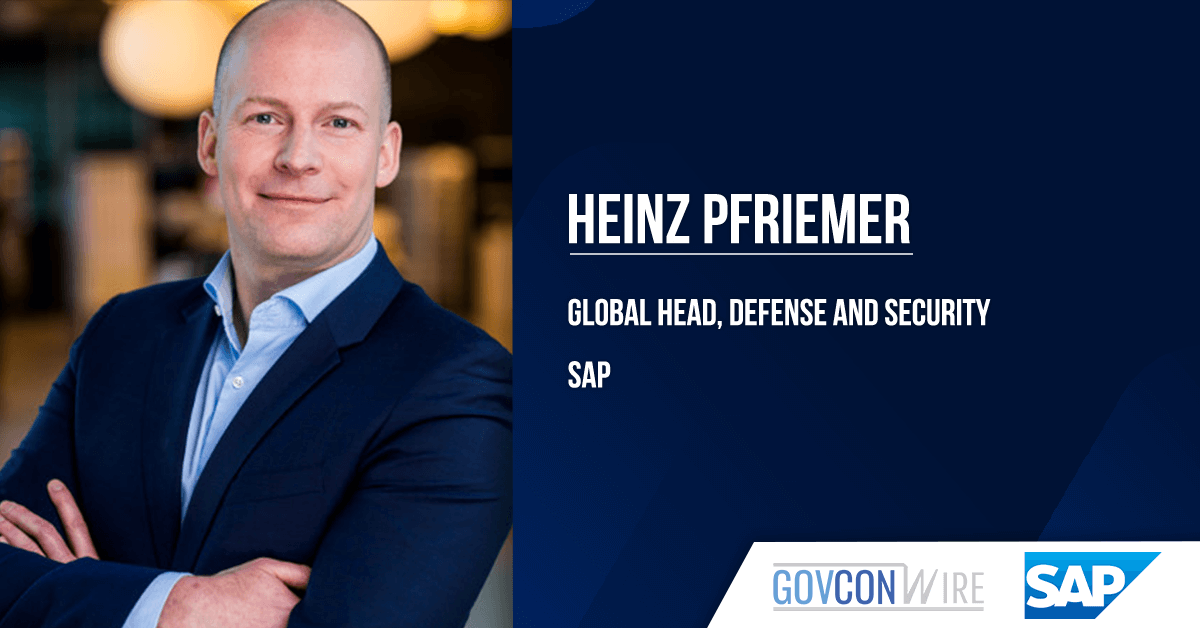By Heinz Pfriemer, Global Head of Defense and Security at SAP
Gartner in May reported that half of organizations expect to use artificial intelligence in contracting by 2027. The 101 procurement leaders surveyed anticipated a productivity boost of more than 20 percent within 18 months of doing so.
That generated a buzz in the procurement world. For the defense establishment, it may take longer for AI to bring such profound improvements in acquisition.
That’s not for a lack of motivation — or need. There’s no shortage of use cases for AI across the acquisition spectrum, from supplier identification and contract writing to pricing- and cost-reasonableness analysis, as well as past performance analysis and even proposal evaluations.
Military procurement agencies are generally understaffed, and the Baby Boomer retirement wave continues to crash down on procurement, where it takes years to become an expert in drafting what can be highly complex and extremely sensitive statements of work and terms and conditions, acquisition and source selection plans, and the details of joint and combined programs.
AI, and in particular, generative AI, promises huge benefits, and the U.S. Army and others are serious about deploying it to save acquisition staff countless hours of grunt work information gathering and boilerplate writing and keeping track of regulatory updates. The idea is to free up human intelligence to focus on higher-level tasks and tough decisions. Two areas look most promising: suppliers and contract authoring.
Supplier Identification and Vetting
GenAI’s superpower is distilling information from a vast universe of sources at speed. The potential set of defense suppliers — from those providing uniforms to those developing next-gen weapons systems or providing operations support services — represents a universe of its own. Commercial vendor databases can be mined for potential candidates, but supplier discovery can do the same with access to an enterprise application’s supplier master data.
A future GenAI tool could root out the capability sets of companies that have previously worked with the organization and narrow the list based on their potential to fulfil the need. By generating a shortlist of potential suppliers that may or may not be in NATO’s source-supplier database for the requirements in question, it could broaden the pool of potential suppliers with minimal staff effort.
Risk is a main component of supplier vetting, and GenAI shows promise here too. GenAI could assess a supplier and its subcontractors to ensure that none is working with sanctioned countries, held by shell companies, are debarred or suspended and so on. Its capabilities extend into helping staff assess business risks such as whether a supplier has a history of delivering on time and on budget and whether they’re financially stable. This is one reason NATO, among others, has incorporated GenAI into their overall AI strategy.
Contract Authoring
Even with contract-writing software, acquisition professionals spend a lot of time drafting statements of work and reviewing terms and conditions. But for security and other reasons, you can’t type “create a draft RFP for a major weapons system” into ChatGPT.
The vision is, with access to large repositories of regulations and existing solicitations (a.k.a., tenders) and contracts, defense-focused GenAI tools could generate draft RFPs and contracts for specialists to then tailor to the specific business needs.
GenAI is well suited to determining the Ts & Cs for a given contract and highlighting apparent incongruencies. For example, how many contracts for landlocked bases have included the DFARS clause 252.247-7023 Transportation of Supplies by Sea?
Contract authoring with GenAI will boost throughput and speed up procurements and holds promise in paring away the least-interesting aspects of acquisition work in favor of genuinely challenging, empowering tasks. That’s attractive to the ambitious young talent that’s needed to scale to meet growing demand, as well as experienced specialists whose time is better spent mentoring them.
On the other hand, GenAI is still a few versions away from addressing many needed capabilities. For example, today, a generic large language model still can’t draft a justification and approval, or J&A, for a sole source procurement based on an international agreement.
Challenges With GenAI in Military Contracting Abound—But They Are Worth Tackling
Given the tremendous benefits AI can bring to the acquisition function, what’s holding it back?
Importantly, GenAI does best when it can train on immense, diverse stores of data. Military data systems tend to be siloed, particularly so in a multinational context such as NATO, and with separate environments for classified and unclassified data.
Further, the requisite pooling of data typically involves cloud environments, and security and data sovereignty can be a concern both with respect to the data pooling and the data environments. And there are also considerations for operating in denied, degraded, intermittent, or limited—a.k.a. DDIL—communications environments.
Aside from connectivity and training models, technical specifications for ballistic missiles are a bad place for an AI hallucination. Psychology and habit can present hurdles as well: an experienced source selection authority may bristle at the idea of a computer drafting their brief for a weapons system.
To solve this, defense procurement organizations can start with using GenAI for nonstrategic, low-risk contracts for commercial items. NATO’s Support and Procurement Agency has updated its AI framework and could host GenAI-powered procurement in a centralized data center that serves its member nations. The FedRamp program just this year announced its cloud security program is opening up to specific GenAI capabilities, including chatbots and code-writing tools. More will surely follow.
It will take longer to integrate GenAI into military acquisitions than in the commercial sphere. But given the technology’s potential, the increasing complexity of military systems, geopolitical uncertainty and persistent staffing challenges, defense organizations should do everything they can to follow quickly.



